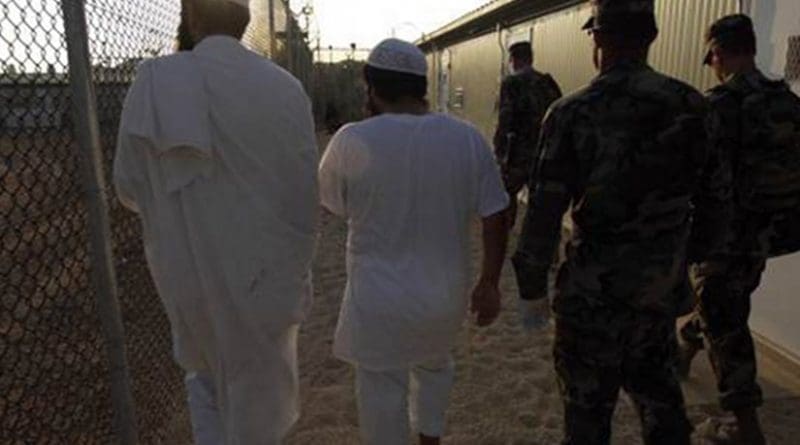Guantanamo Set For Extra Time Under Trump
By Arab News
By Joyce Karam
With just two weeks left in office, US President Barack Obama is planning a final transfer of 19 detainees currently held at Guantanamo Bay in Cuba, leaving behind 40 prisoners, a much smaller number than the 780 when the facility first opened in 2002.
But even with this number, experts agree that Obama will not be able to fulfill his 2008 campaign pledge of closing the military prison.
Instead, on Jan. 20 the current administration will likely be handing over the Guantanamo keys to President-elect Donald Trump, who has been opposed to its closure and has called for a freeze on the detainees’ transfers.
Obama’s final transfer
Three weeks after Trump’s win in the November election, the New York Times broke the news that the Obama administration is planning to transfer an additional 19 detainees from Guantanamo following consultations with Congress.
The 59 detainees remaining at Guantanamo are from Afghanistan (5), Saudi Arabia (6), Pakistan (6), Yemen (27), and 15 from other countries. According to the Washington Post, the final transfer would relocate 19 of those to “the United Arab Emirates and additional inmates to Oman, Saudi Arabia and, possibly, Italy.”
This move is expected to occur any day between now and Jan. 20, according to the White House, and despite objections from Trump.
The president-elect tweeted: “There should be no further releases from Gitmo. These are extremely dangerous people and should not be allowed back onto the battlefield.”
But even with this final push, and amid legal and political hurdles, Obama is expected to fall short on shutting down the facility, experts said.
“The major logistical challenge has always been where exactly do these people go and under what guarantees and conditions,” said Alberto Fernandez, vice-president of the Middle East Media Research Institute in Washington.
“As the number (of prisoners) gets smaller, it becomes harder to close Guantanamo because those remaining are more dangerous and hardcore,” Fernandez, a retired US ambassador, told Arab News.
Adding to the complexity of the debate is the finding that nearly a third of the 693 detainees who have been released from Gitmo returned to terrorist networks, according to data published by the Wall Street Journal.
Ken Gude, a senior fellow with the National Security Team at the Center for American Progress Action Fund policy institute, who has done extensive work on Guantanamo Bay, said the detention center “will not be closed by Obama.”
But other than the logistical hurdles of relocating the detainees, Gude told Arab News that “the real culprit is Congress, which consistently made it harder, if not impossible, to actually close it.”
Earlier last year, Obama proposed to Congress to transfer the eligible detainees, and then move the rest — between 30 and 60 people — to US prisons.
The plan was dead on arrival in the Republican-controlled Congress.
Obama has also emphasized the economic argument in favor of closing Guantanamo, with the total cost amounting to $5.6 billion since 2002, and a $6 million cost-per-detainee after the latest transfers, according to the US Defense Department.
Will Trump expand Gitmo?
During his election campaign, Trump not only promised to keep Gitmo open, but also spoke about adding detainees to the facility. He told an audience in Nevada that “we are keeping (Guantanamo) open… and we’re gonna load it up with some bad dudes, believe me, we’re gonna load it up.”
Fernandez said it is “too early to tell what Trump will do.” This is the same candidate who supported waterboarding during the campaign and abandoned the idea after being electing president. “But it is entirely possible that Trump will want to maintain the camp as an option in case high-level ISIS or Al-Qaeda prisoners are taken alive somewhere.” ISIS is another term for the Daesh terror group.
Such hypothesis, however, collides with changing realities of the counterterrorism operations, said Gude.
“The United States is simply not capturing that many suspected terrorists any more, certainly nothing on the scale of the early years of Guantanamo,” Gude said. “Any increase in the detainee population would be extremely harmful to the United States, but I do not expect to see substantial numbers of new detainees at Guantanamo during the Trump administration.”
While neither expert anticipated that Trump could close Guantanamo as a measure to cut cost, or improve the global standing of the US, Gude said that the Trump administration “will not be able to return to the worst practices of the George W. Bush administration and use it as a location for torture and other abuses outside the reach of law.”
He added: “Too many actions have been taken to make that much, much harder… and make 2017 just vastly different from 2002.”
The detainees now have habeas corpus rights, placing the burden of proof on those detaining them. And with a pre-existing ban on torture, it would be hard to make a return to the Bush era, according to Gude.
Fernandez said that while Guantanamo has “a lot of empty spaces now that could be used,” going back to the 2002 prison numbers, when most of the detainees came from Afghanistan, seems unrealistic and premature.
For Obama, while he will likely leave the White House with Guantanamo still open, rolling back the number of detainees at the facility to almost a quarter of what it was when he took office, is seen by his administration as a positive for his presidential legacy.

